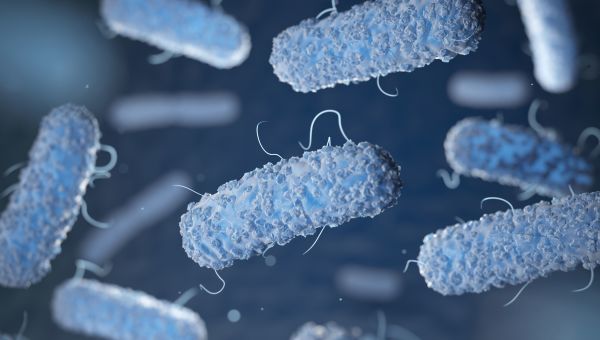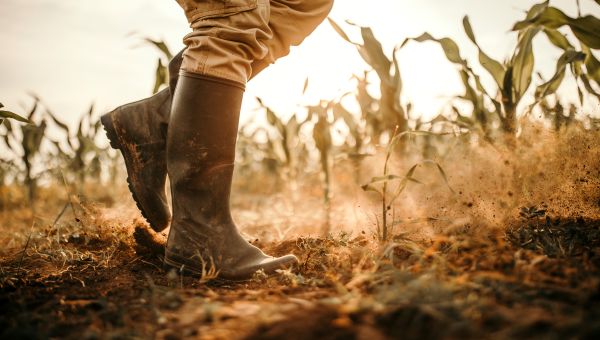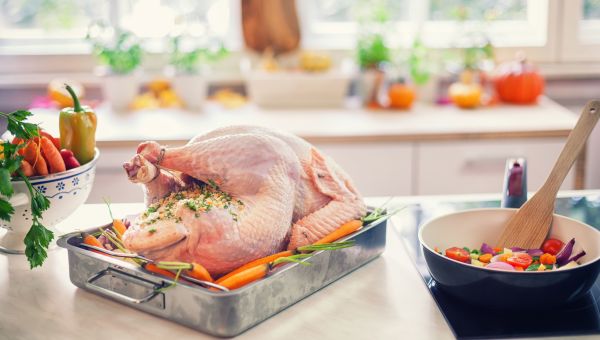10 surprising facts about salmonella, the deadliest foodborne bacteria
Papaya, chicken, and even your pet turtle can make you sick.
Updated on November 28, 2022

You’d like to think that everything you eat is free from germs that could make you sick, but that’s not always the case. When it comes to food poisoning, the bacteria most likely to put you in the hospital—and perhaps even kill you—is Salmonella. Here are the most essential facts about this foodborne bug.

Salmonella is common
Salmonella causes about 1.35 million illnesses per year in the United States, according to the Centers for Disease Control and Prevention (CDC). While a Salmonella infection is uncomfortable and potentially serious, it's rarely fatal—it kills only about 420 people annually, says the CDC.

Salmonella's not just one germ
Salmonella is the genus of the bacteria and there are two species. Within those two species, there are many more subcategories, called serotypes—more than 2,500, in fact.
Don’t worry—you don’t need to know about all 2,500 kinds of Salmonella. Four serotypes—Enteritidis, Typhimurium, Newport, and… Show More
Salmonella is the genus of the bacteria and there are two species. Within those two species, there are many more subcategories, called serotypes—more than 2,500, in fact.
Don’t worry—you don’t need to know about all 2,500 kinds of Salmonella. Four serotypes—Enteritidis, Typhimurium, Newport, and Javiana—account for about half of all lab-confirmed cases, with Enteritidis and Typhimurium being the most common.
Show Less
Salmonella comes from poop
Salmonella bacteria live in the intestines of humans and animals and can be transmitted when food becomes contaminated with small amounts of feces. The bacteria can be introduced into your food at any stage in processing, from harvesting, slaughtering, or manufacturing to preparation.
If a field is… Show More
Salmonella bacteria live in the intestines of humans and animals and can be transmitted when food becomes contaminated with small amounts of feces. The bacteria can be introduced into your food at any stage in processing, from harvesting, slaughtering, or manufacturing to preparation.
If a field is irrigated with Salmonella-contaminated water, for example, fruits or vegetables grown in the field might not be safe. If food factory equipment becomes contaminated or if your kitchen prep surfaces are dirty, the food you eat could be tainted. You could also pick up an infection from coming into contact with the poop of infected animals.
Show Less
You can pick up salmonella almost anywhere
Part of the reason there are so many infections each year is because people can get Salmonella from a number of sources. But humans usually become infected from contaminated food. Between 2014 and 2022, outbreaks in the U.S. have been linked to food products including:
- Chicken and pork
- Fish and … Show More
Part of the reason there are so many infections each year is because people can get Salmonella from a number of sources. But humans usually become infected from contaminated food. Between 2014 and 2022, outbreaks in the U.S. have been linked to food products including:
- Chicken and pork
- Fish and seafood
- Eggs
- Alfalfa and bean sprouts
- Nuts, including pistachios
- Peanut butter
- Fruits and vegetables, including cucumber, papaya, dried coconut, and pre-cut melon
- Packaged cereal
Pets, especially exotic pets, can also infect humans. People who own reptiles, amphibians, and birds are at increased risk of Salmonella.
Show Less
Anyone can get sick
Anyone can be infected with Salmonella and fall ill, but some people are more vulnerable than others. Children under the age of five have higher rates of infection than other age groups. Young kids, the elderly, and people with weakened immune systems are more likely than healthy adults to develop… Show More
Anyone can be infected with Salmonella and fall ill, but some people are more vulnerable than others. Children under the age of five have higher rates of infection than other age groups. Young kids, the elderly, and people with weakened immune systems are more likely than healthy adults to develop severe infections that require hospitalization.
Show Less
Salmonella is rough on your stomach
A Salmonella infection primarily causes acute gastroenteritis, which involves inflammation of the stomach and intestines. This may lead to diarrhea, abdominal pain, and cramps, and occasionally nausea, vomiting, and headaches. You’ll almost always get a fever.
Symptoms typically show up six hours… Show More
A Salmonella infection primarily causes acute gastroenteritis, which involves inflammation of the stomach and intestines. This may lead to diarrhea, abdominal pain, and cramps, and occasionally nausea, vomiting, and headaches. You’ll almost always get a fever.
Symptoms typically show up six hours to six days after being exposed to the bacteria. An infection usually lasts between four and seven days with proper hydration.
However, serious complications can happen if the infection moves out of the gastrointestinal tract and into other parts of the body. These potentially life-threatening infections are medical emergencies, and include:
- Bacteremia: infection of the bloodstream
- Endocarditis: inflammation of the heart’s lining
- Meningitis: infection of the lining of the brain and spinal cord
- Osteomyelitis: bone infection
- Septic arthritis: joint infection
- Urinary tract infection

Salmonella can be hard to detect
Since symptoms can take up to three days to hit, you may not realize your stomach trouble is tied to Salmonella.
To diagnose a Salmonella infection, healthcare providers will first typically take a sample of your stool and get a culture from it, meaning it will be placed in a dish in a laboratory… Show More
Since symptoms can take up to three days to hit, you may not realize your stomach trouble is tied to Salmonella.
To diagnose a Salmonella infection, healthcare providers will first typically take a sample of your stool and get a culture from it, meaning it will be placed in a dish in a laboratory and checked to see what grows. If Salmonella bacteria develops, then your provider knows you were infected. However, since Salmonella infections often go away on their own, your illness might be over by the time the test results come back.
Show Less
Some treatments are no longer as effective
Most suspected cases of Salmonella infection don’t need treatment since they usually clear up on their own. You’ll want to stay hydrated while you’re sick and just ride it out.
If you’re still sick after your stool culture comes back, you may be given antibiotics. They're prescribed to treat… Show More
Most suspected cases of Salmonella infection don’t need treatment since they usually clear up on their own. You’ll want to stay hydrated while you’re sick and just ride it out.
If you’re still sick after your stool culture comes back, you may be given antibiotics. They're prescribed to treat serious infections and for people with an increased risk for complications. The problem is that some strains of Salmonella have become resistant to antibiotics and are therefore harder to treat.
When first-line antibiotics don’t work against Salmonella, doctors often have to prescribe second- or third-choice drugs that may be less effective, more expensive, and have more side effects than preferred drugs.
Show Less
Prevention is simple
If you’re mindful of good hygiene and food preparation, preventing Salmonella infections is pretty easy. Here are some key food preparation best practices to follow:
- Don’t eat raw or undercooked meat or eggs or unpasteurized milk. Safe minimum internal temperatures for cooking are 165 degrees … Show More
If you’re mindful of good hygiene and food preparation, preventing Salmonella infections is pretty easy. Here are some key food preparation best practices to follow:
- Don’t eat raw or undercooked meat or eggs or unpasteurized milk. Safe minimum internal temperatures for cooking are 165 degrees Fahrenheit (°F) for poultry, 160°F for ground meat and 145°F for beef, pork, ham, and lamb steaks, chops and roasts and fish and shellfish. Eggs should be cooked all the way through.
- Avoid cross-contamination when preparing food. Have dedicated areas for each type of food including meat, poultry, and vegetables. Wash cutting boards, plates, utensils, and surfaces—and your hands—with soap and water after they’ve touched raw food. And despite what you may have heard, do not wash raw chicken or other poultry before cooking it. This includes whole birds and parts, like pre-cut breasts and thighs. Even if you’re careful, rinsing raw poultry in your sink can spread germs throughout the kitchen and onto other foods or utensils.
- Exercise additional caution when preparing food for those most vulnerable to Salmonella infection, including young children and infants, the elderly, and the immunocompromised
Of course, you should also wash your hands thoroughly with soap and water after handling pet reptiles, amphibians, and birds, or their droppings—and don’t let kids five years old or younger handle them at all. If older children do handle potentially infected animals, be sure to supervise them when they wash their hands.
Show Less
The latest info is at your fingertips
The CDC tracks past and active Salmonella outbreaks. You can also check with the U.S. Food and Drug Administration, which keeps a running list of food and product recalls, including those recalled due to fears of Salmonella contamination.

Centers for Disease Control and Prevention. Salmonella: Information for Healthcare Professionals and Laboratories. Page last reviewed August 31, 2022.
World Health Organization. Salmonella (non-typhoidal). February 20, 2018.
FoodSafety.gov. Salmonella and Food. Accessed November 22, 2022.
FoodSafety.gov. Bacteria and Viruses: Salmonella. Accessed November 22, 2022.
Centers for Disease Control and Prevention. Salmonella: Reports of Selected Salmonella Outbreak Investigations. Last reviewed October 20, 2022.
Centers for Disease Control and Prevention. Salmonella: Questions and Answers. Page last reviewed September 9, 2022.
Centers for Disease Control and Prevention. Salmonella: Symptoms. Page last reviewed December 12, 2019.
MedlinePlus. Salmonella Infections. Last updated August 4, 2016.
MedlinePlus. Fecal culture. Reviewed April 11, 2020.
Mayo Clinic. Salmonella infection. April 29, 2022.
FoodSafety.gov. Cook to a Safe Minimum Internal Temperature. Date last reviewed November 2, 2022.
Centers for Disease Control and Prevention. Salmonella: Prevention. Page last reviewed February 8, 2019.
More On


video

article

slideshow


video


video
